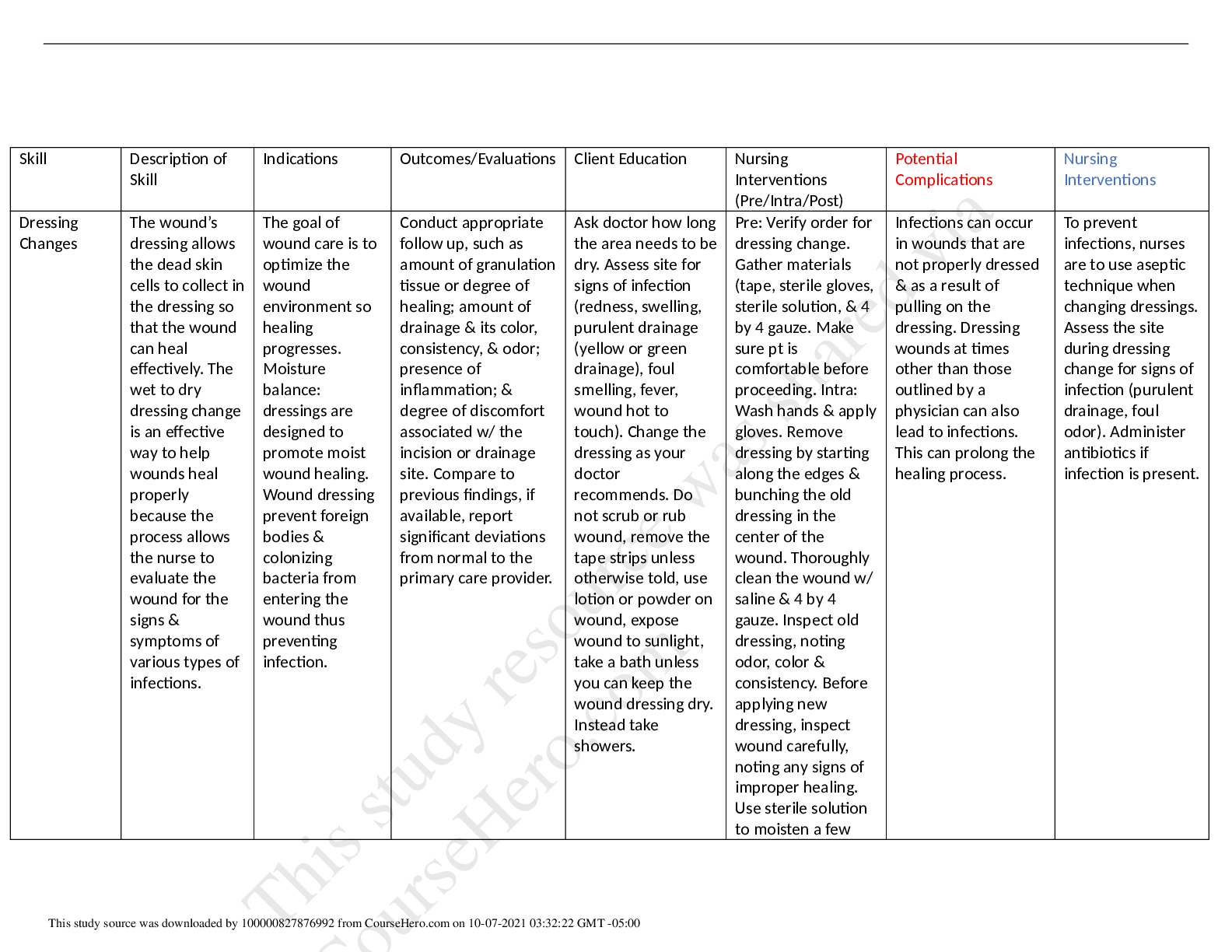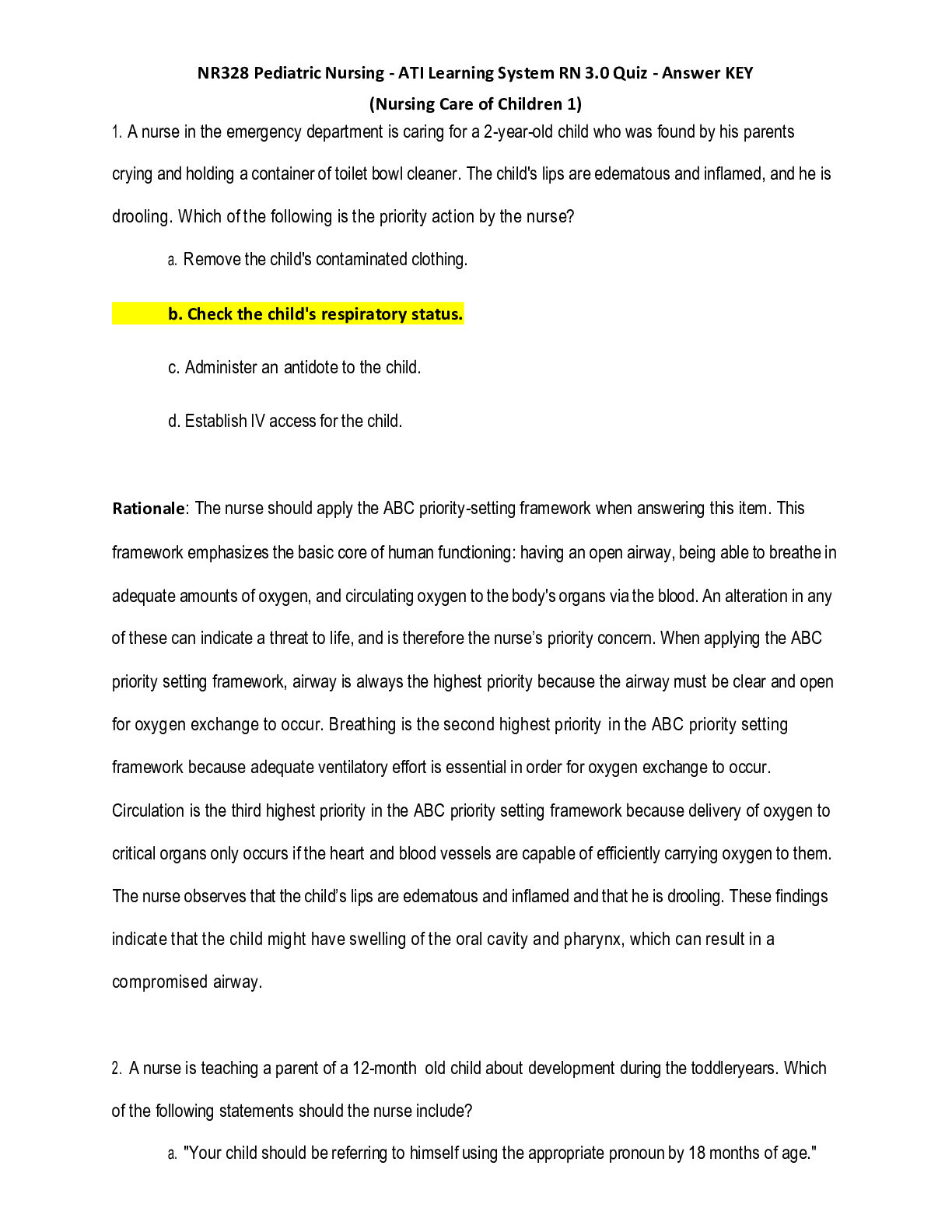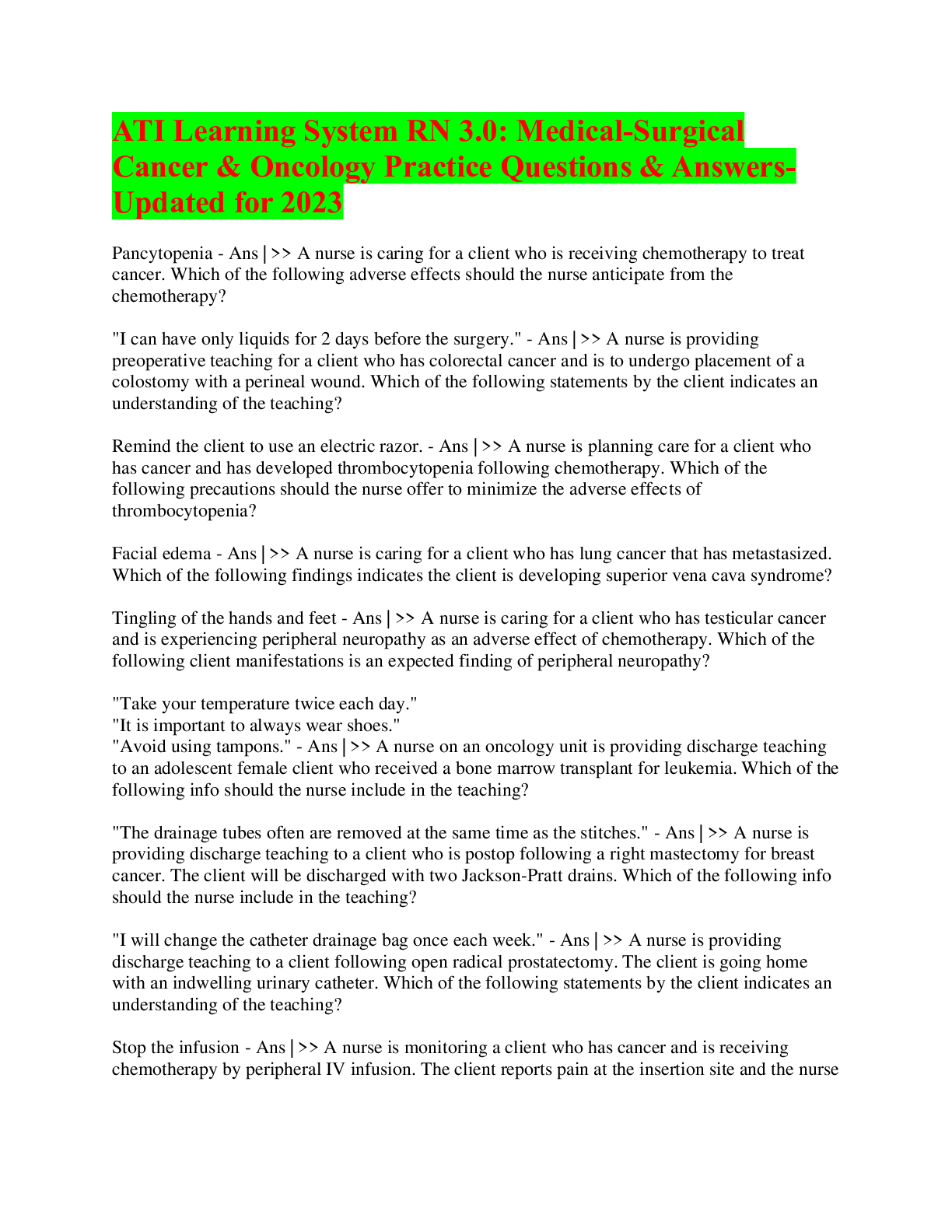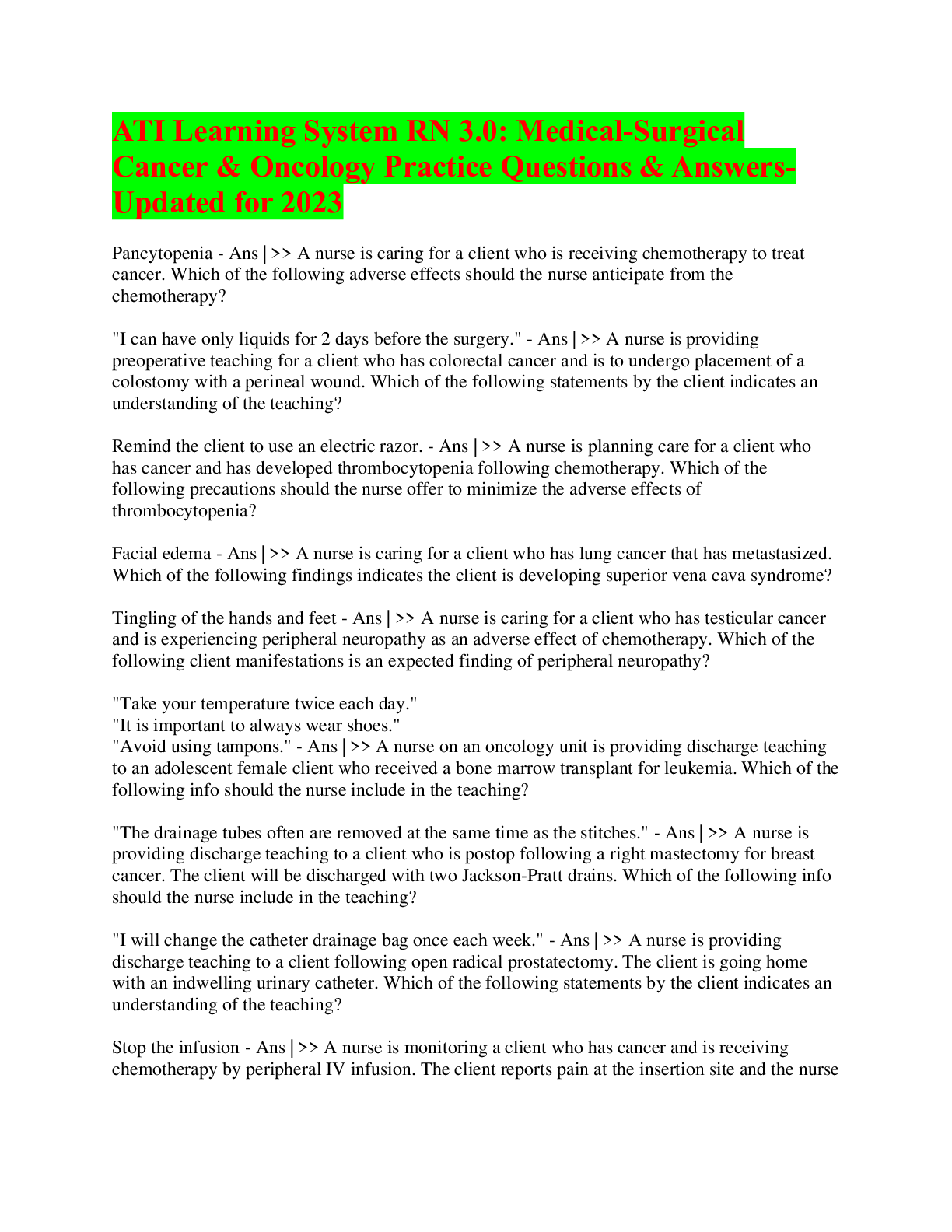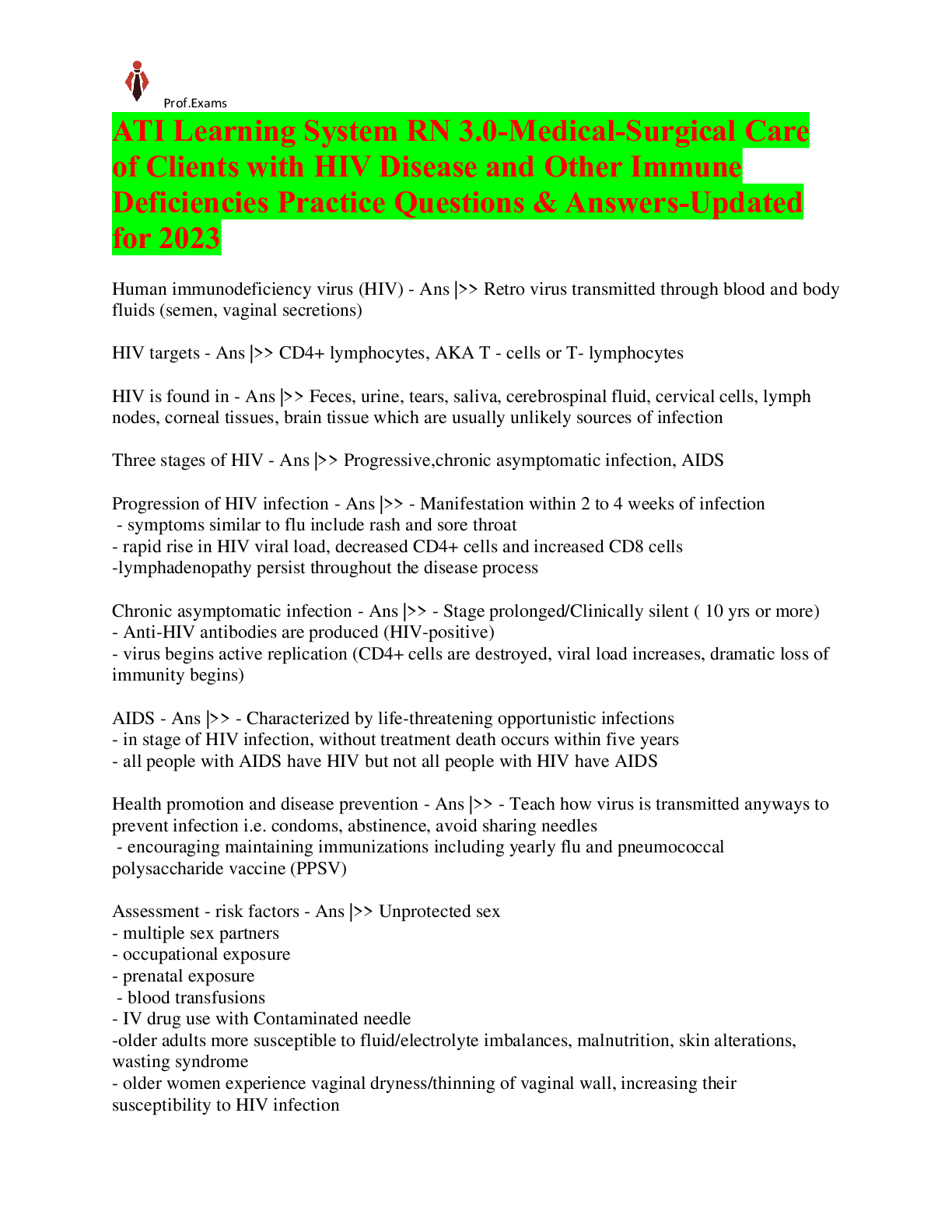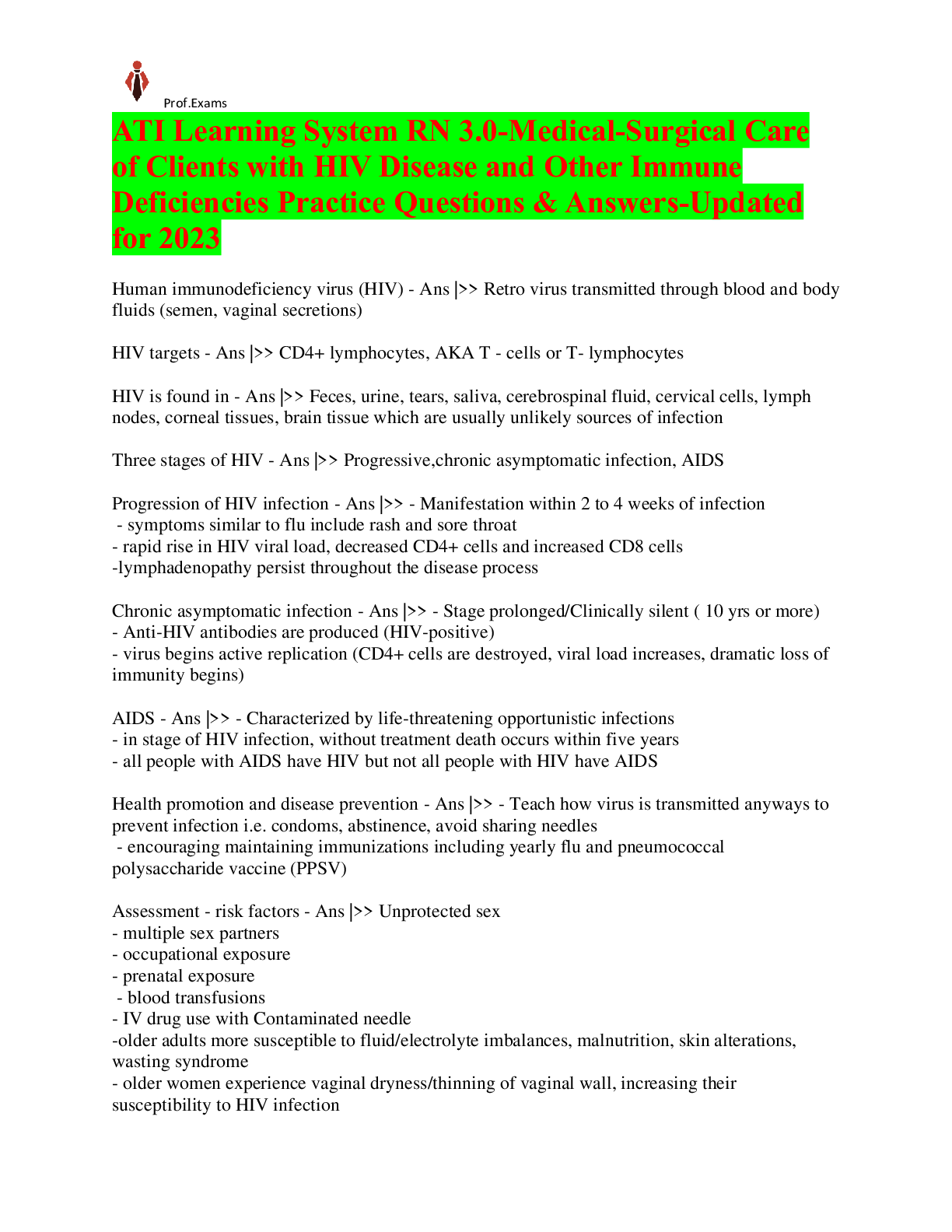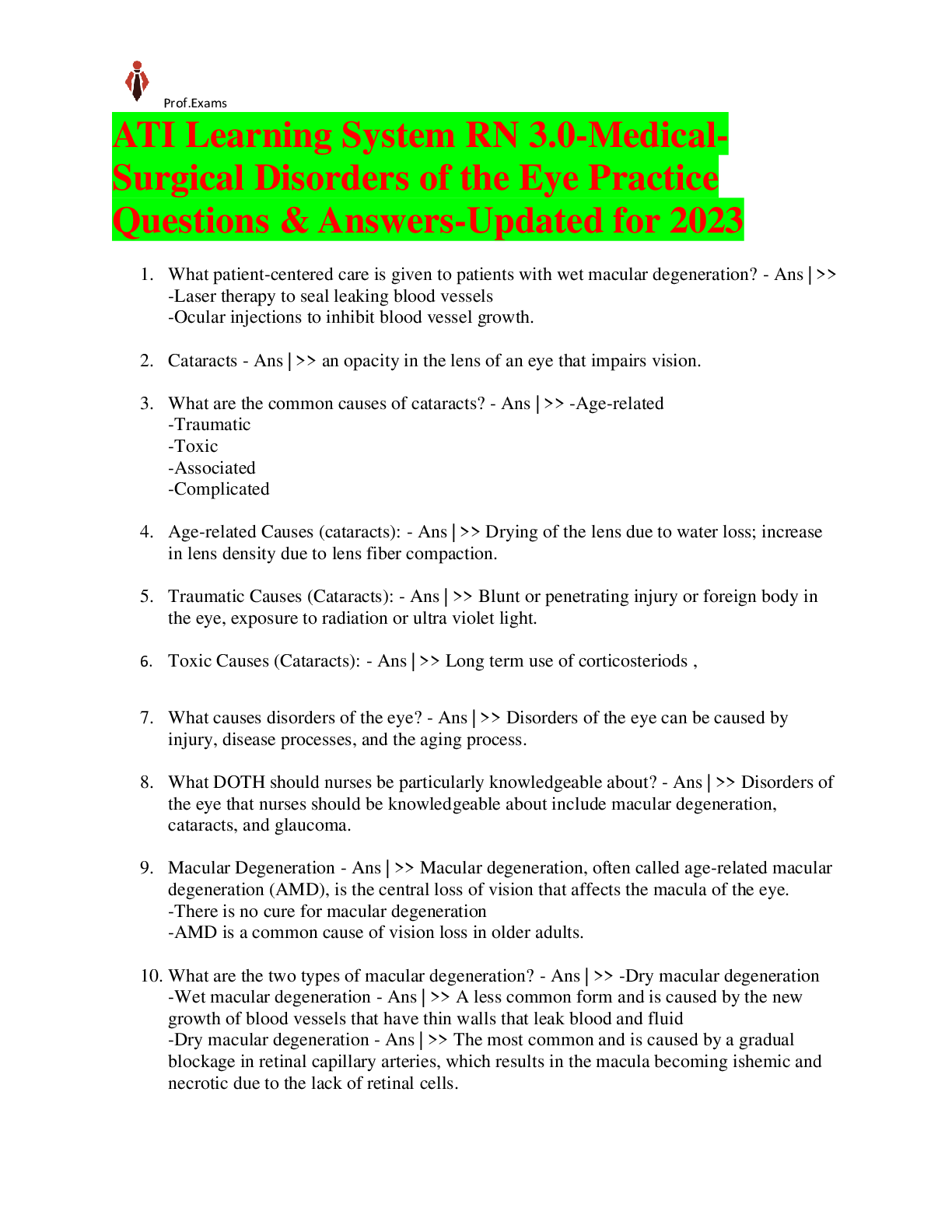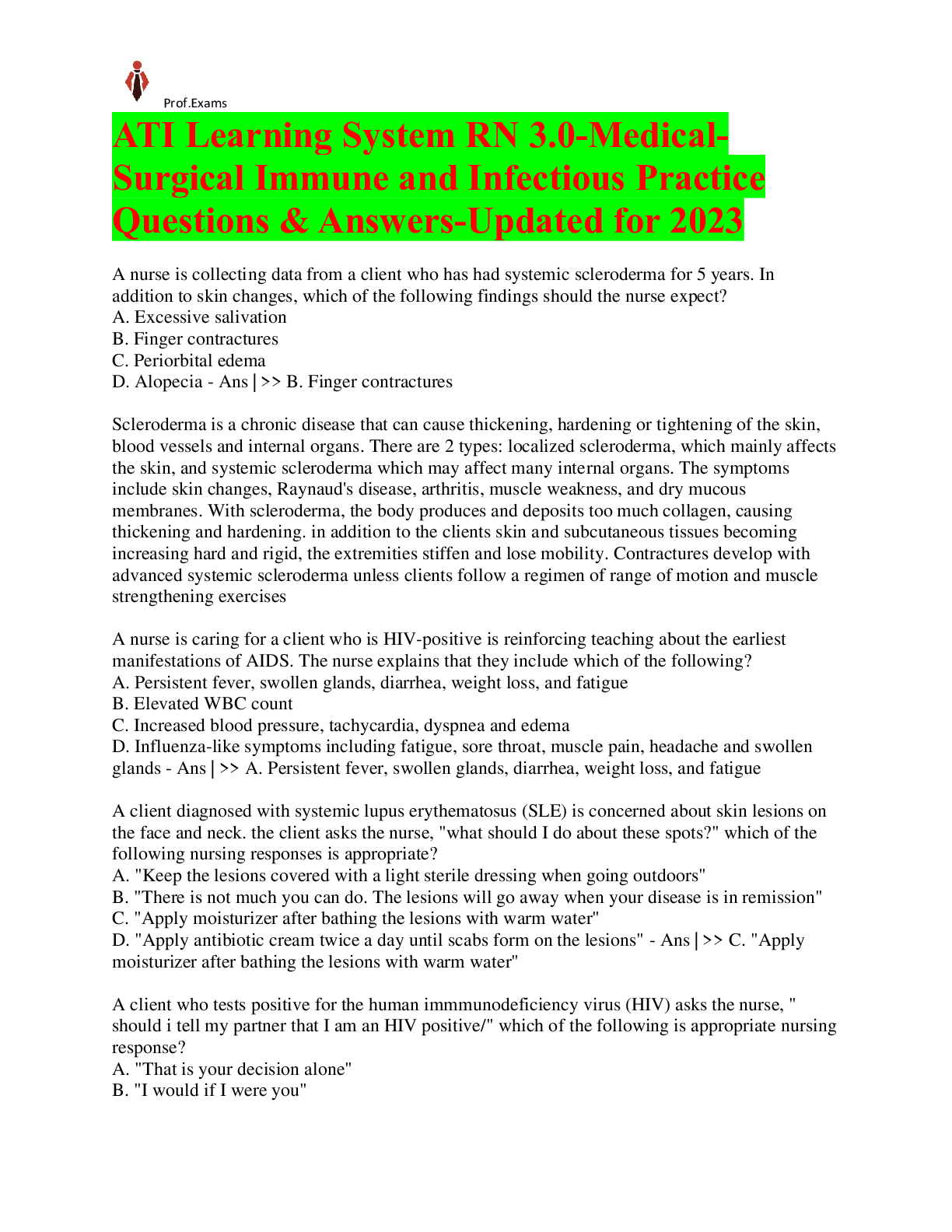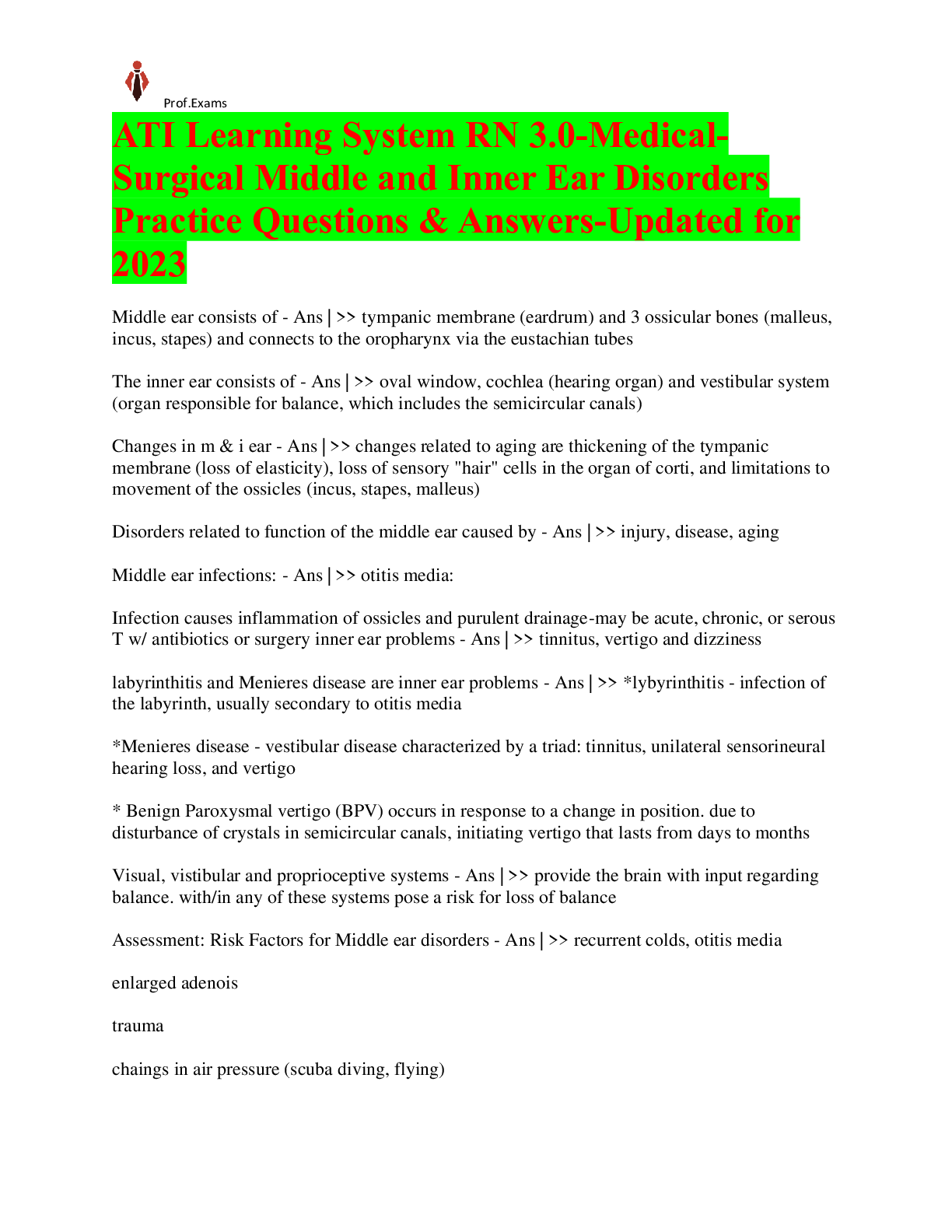*NURSING > ATI MEDICAL SURGICAL > ATI Targeted Medical-Surgical Assessment: Endocrine, Musculoskeletal ,Calculations: Dosage By Weight (All)
ATI Targeted Medical-Surgical Assessment: Endocrine, Musculoskeletal ,Calculations: Dosage By Weight, Calculations: Parenteral IV Medications, ATI Learning System RN: Fundamentals Final Quiz : (answered) complete solution_2020.
Document Content and Description Below
ATI Targeted Medical-Surgical Assessment: Endocrine, Musculoskeletal ,Calculations: Dosage By Weight, Calculations: Parenteral IV Medications, ATI Learning System RN: Fundamentals Final Quiz : (answer... ed) complete solution_2020. ATI Targeted Medical-Surgical Practice Assessment: Endocrine 1. A nurse in an outpatient clinic is teaching a client who has a diabetic foot ulcer about foot care. Which of the following statements by the client indicates an understanding of the teaching? 2. A nurse is assessing a client who has diabetes mellitus and reports feeling anxious. Which of the following findings should the nurse expect if the client is hypoglycemic? 3. A nurse is caring for a client who has Type 2 Diabetes Mellitus and is admitted with hyperglycemic-hyperosmolar (HHS). Which of the following laboratory findings should the nurse expect? 4. A nurse is preparing insulin for a client who has diabetes mellitus. The client is to receive evening doses of insulin glargine and regular insulin. Which of the following actions should the nurse take to administer these two medications safely? 5. A nurse is monitoring a client's status 24 hr after a total thyroidectomy. Which of the following findings should the nurse report to the provider? 6. A nurse is caring for a client who has diabetes mellitus and developed peripheral neuropathy. Which of the following measures should the nurse recommend to prevent injuries to his feet? 7. A nurse is planning preoperative care for a client who has pheochromocytoma. Which of the following interventions should the nurse anticipate as being priority? 8. A nurse is caring for a client following thyroidectomy. The nurse should assess for which of the following findings as an indication of hypocalcemia? 9. A nurse is preparing to administer propranolol by IV bolus to a client experiencing thyroid storm. Which of the following findings indicates the client is having a therapeutic response? 10. A nurse is providing teaching for a client who has diabetes mellitus. Which of the following findings associated with DKA should the nurse include? 11. A nurse is assisting a client who has adrenal insufficiency. Which of the following findings should the nurse expect? 12. A nurse is managing care of a client who is postoperative and experiencing acute adrenal insufficiency. Which of the following actions should the nurse take? 13. A nurse is assessing a client who has a new diagnosis of Cushing's disease. Which of the following findings should the nurse expect? 14. A nurse is admitting a client who has hyperthyroidism. When assessing the client, the nurse should expect which of the following findings? 15. A nurse is providing teaching for a client who has type 1 diabetes mellitus about how to prevent complications during illness. Which of the following statements indicates that the client understands the teaching? 16. A home health nurse is assessing a client who is on lifelong hormone replacement therapy for treatment of hypothyroidism. The client has not been taking his medication regularly. Which of the following findings should the nurse expect? 17. A nurse is caring for a client undergoing screening for primary Cushing's disease. The nurse should expect that which of the following laboratory findings to be elevated? 18. A nurse is developing a teaching plan for a client who had a thyroidectomy and takes a thyroid hormone replacement. Which of the following instructions should the nurse plan to include? 19. A nurse is providing discharge teaching for a client who has diabetes insipidus and has a new prescription for desmopressin nasal spray. Which of the following instructions should the nurse include in the teaching? 20. A nurse is teaching a client about glycosylated hemoglobin (HbA1c) testing. Which of the following statements by the client indicates an understanding of the information about this test? 21. A nurse is performing an assessment on a client who has syndrome of inappropriate antidiuretic hormone (SIADH). Which of the following assessment data should the nurse report? 22. A nurse is preparing a teaching plan for a client who has diabetes insipidus and is receiving intranasal desmopressin. Which of the following information should the nurse include in the teaching plan? 23. A nurse is preparing to give a client information about adrenocorticotropic hormone (ACTH) stimulation test. The nurse should explain that the purpose of the test is to assess for which of the following disorders? 24. A nurse is planning dietary teaching for a client who has type 1 diabetes mellitus. Which of the following information should the nurse include regarding alcohol consumption? 25. A nurse is monitoring the laboratory values of a client who has diabetes mellitus and is taking insulin. Which of the following results indicates a therapeutic outcome of insulin therapy? 26. A nurse is teaching a client who has autoimmune disease about the adverse affects of long-term corticosteroid therapy. Which of the following effects should the nurse include? (select all that apply) 27. A nurse is caring for a client who is taking propylthiouracil (PTU). The nurse should recognize that the client has met the treatment goals when she reports an increase in which of the following effects? 28. To screen a client for pheochromocytoma, a nurse schedules a vanillylmandelic acid test. When teaching the client about this test, which of the following instructions should the nurse include? 29. A nurse is assessing a client for diabetes insipidus. The nurse should expect which of the following findings? 30. A nurse is reviewing laboratory values for a client who has diabetic ketoacidosis (DKA). Which of the following findings should the nurse expect? 31. A nurse is caring for a patient that had DM type 2 and HHS. Which of the following lab values should the nurse expect to find? 32. A nurse is teaching a patient about diabetes type 1. Which of the following should the nurse include? Musculoskeletal: 1. basilar skull fracture - following assessment findings should the nurse report to the provider? 2. ED client suddenly lost consciousness in home and fell - embolic stroke - which med? tissue plasminogen activator RA - expected findings? 3. pain assessment post-op - findings to determine severity of pain? 4. teaching a client and fam about dx and tx of alzheimer's - indication the fam understands? 5. right hemispheric stroke - neuro deficits should the nurse expect? 6. client w advancing amyotrophic lateral sclerosis - which intervention is priority? 7. new dx of osteoarthritis - expected findings? SATA 8. quad - throbbing pain and nausea - facial flushing and bp 220/110 - which action first? 9. retinal detachment - expected? 10. teaching AP about care for total hip arthroplasty - instructions? 11. Parkinson's carvidopa-levodopa - client understands? 12. post-op instructions following cataract surgery - indication client understands? 13. teaching plan for Meniere's Diseases - instructions to include? 14. client w hx of status epilepticus & seizure precautions - which action? 15. head injury following MVA - finding indicates increased ICP? 16. MS - expected finding? 17. 72 post-op AKA & reports phantom limb pain - which action? 18. ER sudden, severe eye pain w blurry vision - primary angle-closure glaucoma - medication? 19. IMAGA - comminuted fracture? 20. full arm cast pain 8/10 & meds don't relieve - which action? 21. epilepsy and to start phenytoin - which instruction to include in med plan? 22. post op right hip arthroplasty IMAGE 23. viral meningitis - which action? 24. stroke and right-sided homonymous hemianopsia - to help adapt which action? 25. ER w myasthenia gravis - increasing muscle weakness & suspected myasthenic crisis - priority? 26. spastic bladder following spinal cord injury - stimulate micturition? 27. osteoporosis and new rx for alendronate - include in teaching? 28. closed head injury from fall and receiving mech vent - priority? 29. balanced suspension skeletal traction and reports intermittent muscle spasms - first action? Calculations: Dosage By Weight: A nurse is preparing 50mg/kg/day q6hr to child 88lb. Available 250mg/5ml. how much ml administer per dose? Give famotidine 0.5mg/kg to child who weighs 50lb. how much mg administer per dose? Give amoxicillin 25mg/kg/day q8hr to child who weigh 43lb. available is 250mg/5ml. how much ml per dose? Give acyclovir 5mg/kg to pt who weighs 75lb. how many mg to administer per dose? Give phenytoin 15mg/kg/day q8hr to pt who weighs 120lb. available is 125mg/5ml. How ,many ml to administer per dose? Give epoetin alfa 50units/kg to pt who weighs 40lb. Available 2,000 units/ml. How many ml to administer? Give potassium chloride 5mEq/kg/day q6hr to pt weighs 64lb. Available is 40 mEq/15 ml. How many ml to administer per dose? Converting lb to kg, 20lb 8oz to kg? Give phenytoin 5mg/kg bolus stat to infant who weighs 12 lb 4 oz. How many mg should be administer? Convert lb to kg. 17 lb 9oz to kg? Give tobramycin 2.5 mg/kg IM to pt who weighs 20kg. available is 40mg/ml. how many ml administer per dose? Give 3mEq/kg/day PO q6hr to PT who weighs 42 lb. Available 20mEq/ 15ml. How many ml administer per dose? Give 45 mg/kg/day PO q8hr to pt weigh 66 lb. Available is 250mg/5 ml. How many ml administer per dose? Give ceftazidime 30 mg/kg/day IV q8hr to toddler weighs 22 lb. Available is 280mg/ ml. How many ml per dose? convert lb to kg. 10lb 4 oz to kg. Give EryPed 50mg/kg/day PO q6hr to pt weigh 32lb. Available is 200mg/5ml. How many ml per dose? Give 2mEQ/KG PO to pt who weighs 50lb. how many mEq per dose? Convert lg to kg, 6lb 2 oz to kg? Give 40 mg/kg/day PO Q8HR, pt weighs 48 lb. Available is 375mg/ 5 ml. How many ml? Amoxil 30 mg/kg/day PO q12hr to infant weighs 5.5 kg. Available is 125 mg/5 ml. How many ml per dose? Calculations: Parenteral IV Medications Cleocin 400 mg iv bolus Rocephin 2g IV Vancomycin 1g q12h Dextrose 5% in 0.45% NS 1500 ml over 8 hrs. Zinacef 500mg IV Sodium Chloride (0.9%) 1000ml for 5hr Lactated Ringer's 2L Drop Rate 10 gtt/ml Ranitidine 50 mg over 8 hr Dextrose (D5W) 125 ml drop rate 15 gtt/ml NaCl 500 ml over 6hr drop rate 60 gtt/ml Protonix 80 mg q12hr 0.45% NaCl 750 ml IV drop rate 60 gtt/ml Dextrose (D5W) 250 ml q15min bolus Zofran 4 mg IV bolus 0.9 NaCl Ancef 250 mg q8hr Nacl 500ml IV over 2hr Drop rate 10 gtt/ml Dextrose 1L IV OVER 12HR Drop rate 15 gtt/ml Fortaz 1g IV bolus 0.9% NaCl 1.5L IV drop rate 20 gtt/ml Lactated Ringer's 1L Drop rate 15gtt/ ml ATI Learning System RN: Fundamentals Final Quiz 1. A nurse in a provider's office is assessing a client who has heart failure. The client has gained weight since her last visit and her ankles are edematous. Which of the following findings by the nurse is another clinical manifestation of fluid volume excess? 2. A nurse is caring for a client who is postoperative following abdominal surgery. Which of the following actions should the nurse take first after discovering that the clients wound has eviscerated? 3. A nurse in a provider's office is collecting information from an older adult client who reports that he has been taking acetaminophen 500 mg/day for severe joint pain. The nurse should instruct the client that large doses of acetaminophen could cause which of the following adverse effects? 4. A nurse is teaching a client who has lower extremity weakness how to use a four-point crutch gait. Which of the following instructions should the nurse include in the teaching? 5. A nurse is planning to document care provided for a client. Which of the following abbreviations should the nurse use? 6. A nurse is responding to a parents question about his infants expected physical development during the first year of life. Which of the following information should the nurse include? 7. An assistive personnel (AP) is assisting a nurse with the care of a female client who has an indwelling catheter. Which of the following actions by the AP indicates a need for further teaching? 8. A newly licensed nurse is preparing to administer medications to a client. The nurse notes that the provider has prescribed a medication that in unfamiliar to her. Which of the following actions should the nurse take? 9. A nurse is providing oral care for a client who is unconscious. Which of the following actions should the nurse take? 10. A nurse is planning to perform passive range-of-motion exercises for a client. Which of the following actions should the nurse take? 11. A nurse is teaching a client who is postoperative how to use a flow-oriented incentive spirometer. Which of the following instructions should the nurse include? 12. A nurse is teaching a client how to self-administer insulin. Which of the following actions should the nurse take to evaluate the clients understanding of the process within the psychomotor domain of learning? 13. A nurse is providing teaching about food choices to a client who has a prescription for a clear liquid diet. Which of the following selections by the client indicates an understanding of the teaching? 14. A nurse is performing a neurological assessment for a client. Which of the following examinations should the nurse use to check the clients balance? 15. A nurse in a providers office is reviewing the laboratory findings of a client who reports chills and aching joints. The nurse should identify which of the following findings as an indication that the client has an infection? 16. A nurse is preparing to administer an intramuscular injection to a young adult client. Which of the following injection sites is the safest for this client? 17. A nurse is applying an ice bag to the ankle of a client following a sports injury. Which of the following actions should the nurse take? 18. A client Is being discharged home with oxygen therapy via a nasal cannula. Which of the following instructions should the nurse provide to the client and family? 19. A nurse is caring for a client who is 48 hr postoperative following a small bowel resection. The client reports gas pains in the periumbilical area. The nurse should plan care based on which of the following factors contributing to this postoperative complication? 20. A nurse is planning the insert a nasogastric tube for a client after explaining the procedure. The client states, "you are not putting that hose down my throat." Which of the following statements should the nurse make? 21. A nurse is preparing to administer a cleansing enema to a client. Which of the following actions should the nurse plan to take? 22. A nurse on a surgical unit is receiving a client who had abdominal surgery from the post-anesthesia care unit. Which of the following assessments should the nurse make first? 23. A nurse is caring for a client who has a prescription for a vest restraint. Which of the following actions should the nurse take? 24. A nurse is caring for a client who has a fecal impaction. Before digital removal of the mass. Which of the following types of enemas should the nurse plan to administer to soften the feces? 25. A nurse is providing education about cultural and religious traditions and rituals related to death for the assistive personnel on the unit. Which of the following information should the nurse include? 26. A nurse is reviewing the correct use of a fire extinguisher with a client. Which of the following actions should the nurse direct the client to take first? 27. A nurse is preparing to provide chest physiotherapy for a client who has left lower lobe atelectasis. Which of the following actions should the nurse plant to take? 28. A nurse is planning care for a client who is postoperative and has a history of poor nutritional intake. Which of the following actions should the nurse include in the plan of care to promote wound healing? 29. A nurse is caring for a client who has a terminal illness. Which of the following findings indicates that the client's death is imminent? 30. A nurse is caring for a client who Is receiving a blood transfusion. The client reports flank pain and the nurse nots reddish-brown urine in the client's urinary catheter bag. The nurse recognizes these manifestations as which of the following types of transfusion reactions? 31. A nurse on a mental health unit is preparing to terminate the nurse-client relationship with a client who no longer requires care. Which of the following concepts would the nurse and client discuss in the termination phase of the relationship? 32. A nurse is caring for a client who has bilateral casts on her hands. Which of the following actions should the nurse take when assisting the client with feeding? 33. A nurse is caring for a client who has clostridium difficile and is in contact isolation. Which of the following actions should the nurse take? 34. A nurse is planning care for a client who has a single-lumen nasogastric (NG) tube for gastric decompression. Which of the following actions should the nurse include in the plan of care? 35. A nurse is called away for an emergency while conversing with a client who is concerned about his medical diagnosis. The nurse returns to the client promptly, as promised. Which of the following ethical principles is the nurse demonstrating? 36. A nurse in the emergency department is caring for a client who has abdominal trauma. Which of the following assessment findings should the nurse identify as an indication of hypovolemic shock? 37. A nurse is reviewing the laboratory values for a client who has a positive chvostek's sign. Which of the following laboratory findings should the nurse expect? 38. An adolescent client in an outpatient mental health facility tells the nurse that it is hard to follow his treatment plans because his friends discourage him. Which of the following statements should the nurse make? 39. A nurse is reviewing measures to prevent back injuries with assistive personnel (AP). Which of the following instructions should the nurse include? 40. A nurse on a telemetry unit is caring for a client who has a myocardial infarction. The client states "all this equipment is making me nervous" which of the following responses should the nurse make? [Show More]
Last updated: 2 years ago
Preview 1 out of 11 pages

Buy this document to get the full access instantly
Instant Download Access after purchase
Buy NowInstant download
We Accept:

Reviews( 0 )
$18.00
Can't find what you want? Try our AI powered Search
Document information
Connected school, study & course
About the document
Uploaded On
Oct 21, 2020
Number of pages
11
Written in
Additional information
This document has been written for:
Uploaded
Oct 21, 2020
Downloads
0
Views
221

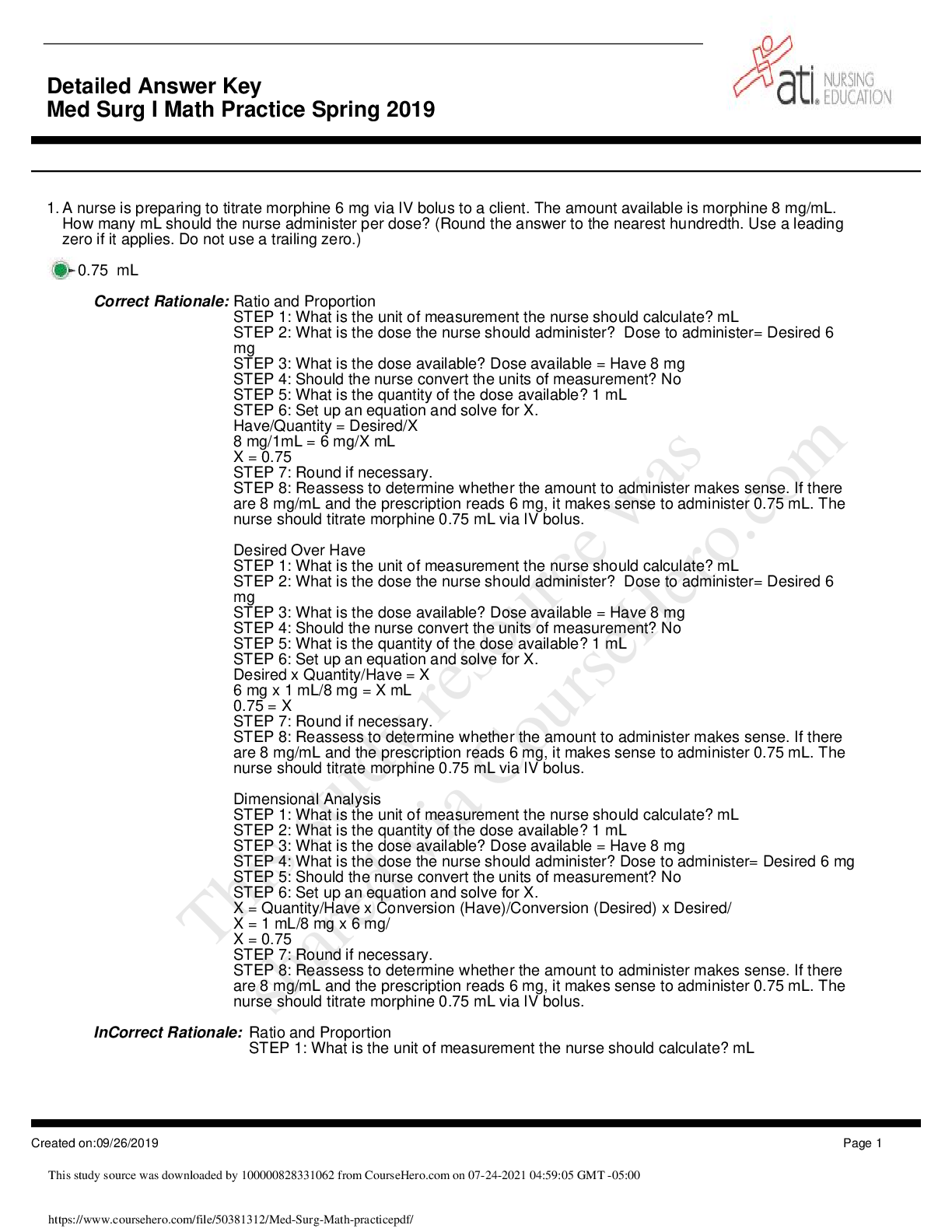
 Adult Medical Surgical.png)
